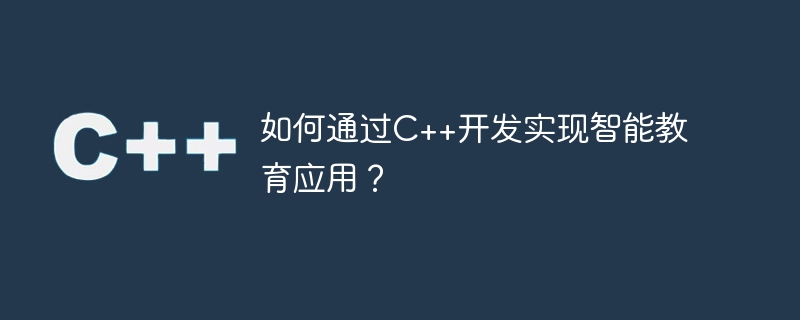

How to develop intelligent education applications through C?
Introduction:
With the continuous development of technology, intelligent educational applications are playing an increasingly important role in the field of education. As a powerful programming language, C can provide rich functions and efficient performance, which brings great convenience to the development of intelligent education applications. This article will introduce how to use C to develop intelligent education applications and give corresponding code examples.
1. Basic functions of intelligent education applications
The first step in developing intelligent education applications is to clarify their basic functions so that development work can be carried out better. Intelligent education applications usually have the following basic functions:
2. Use C for development
After clarifying the basic functions of intelligent education applications, we can use C to implement these functions. The following is a simple code example that demonstrates how to use C to implement student management functions.
class Student {
public:
string name;
int age;
string class;
};#include <vector>
class StudentManager {
private:
vector<Student> students;
public:
void addStudent(Student student) {
students.push_back(student);
}
void printStudents() {
for (int i = 0; i < students.size(); i++) {
cout << "Name: " << students[i].name << endl;
cout << "Age: " << students[i].age << endl;
cout << "Class: " << students[i].class << endl;
cout << endl;
}
}
};int main() {
StudentManager studentManager;
Student student1;
student1.name = "张三";
student1.age = 18;
student1.class = "一年级一班";
studentManager.addStudent(student1);
Student student2;
student2.name = "李四";
student2.age = 19;
student2.class = "一年级二班";
studentManager.addStudent(student2);
studentManager.printStudents();
return 0;
}The above sample code demonstrates how to use C to implement the student management function. We create a student class and then use the student management class to add students and print student information. Through the above code examples, we can see that C provides simple and intuitive syntax and rich data types to facilitate our development work.
3. Further development
In addition to student management, we can also use similar methods to implement other functions, such as course management, grade management, teacher management, homework management, etc. In each functional class, we can define different methods to implement the corresponding functions and enrich the functionality of the application.
In addition, during the development process, we can use the library functions and algorithms provided by C to optimize the code and improve the performance of the application. For example, you can use the containers and algorithms provided by STL to simplify code and increase application flexibility. At the same time, you can use file operation functions to achieve persistent storage of data to facilitate long-term use of data.
4. Summary
Through the introduction of this article, we have learned how to use C to develop intelligent education applications. We explained the basic functions of smart education applications and gave code examples for student management functions. By using C, we can easily implement various functions and optimize application performance through the library functions and algorithms provided by C. Of course, in addition to student management, we can further develop other functions to meet actual needs. I hope this article can provide some guidance for developing intelligent education applications in C.
The above is the detailed content of How to implement intelligent education applications through C++ development?. For more information, please follow other related articles on the PHP Chinese website!
 How to solve discuz database error
How to solve discuz database error
 latex usage
latex usage
 What are the search sites?
What are the search sites?
 The difference between windows hibernation and sleep
The difference between windows hibernation and sleep
 Dynamic link library initialization routine failed
Dynamic link library initialization routine failed
 How to check ports in Linux
How to check ports in Linux
 Why can't the Himalayan connect to the Internet?
Why can't the Himalayan connect to the Internet?
 Introduction to the main work content of the backend
Introduction to the main work content of the backend
 How to close the window opened by window.open
How to close the window opened by window.open




